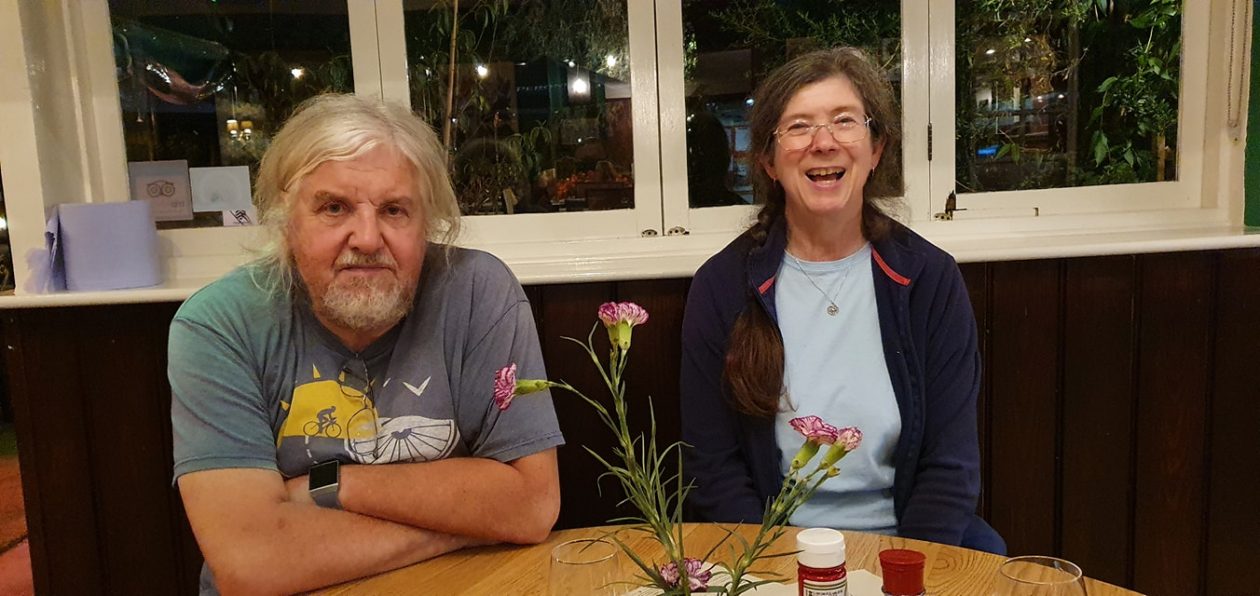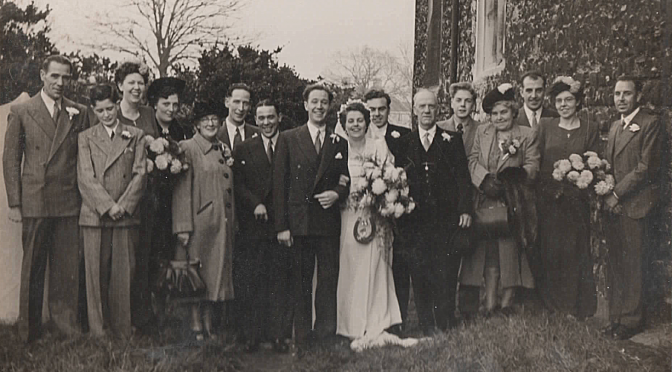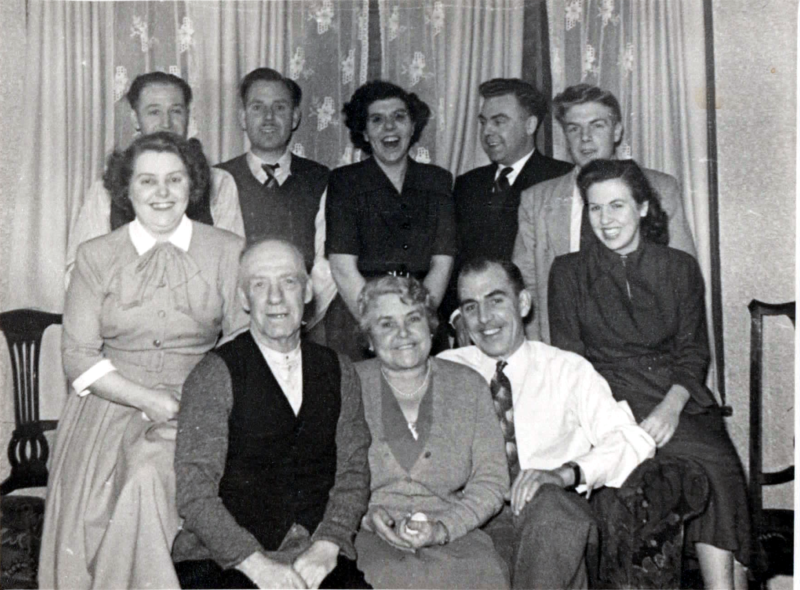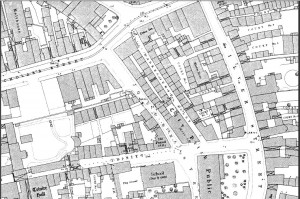I’ve had this photo hanging around for quite some time. If I’ve ever scanned it before I’ve lost track. Anyway, it showed up the other day and I scanned it again.
It’s the family portrait at my parents’ wedding. It was Saturday 20th November, 1948 at St Mary Magdalen, East Ham.
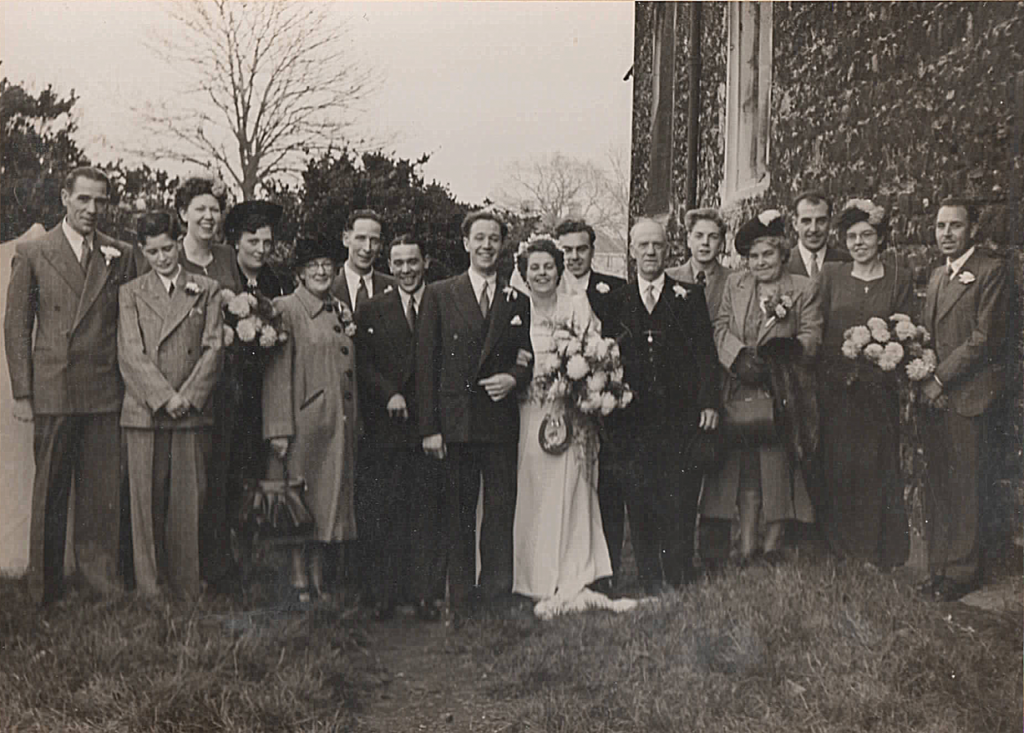
Almost everyone in both immediate families is there. Obviously in the centre we see my father, James Edward with his new wife, and my future mother, Hilda Beatrice Clare. On the left as you look are most of the Gillett side, including three of his brothers and his sister.
On the far left, I think, is father’s eldest brother, William. “Uncle Bill” to me. His full name was William Walter Thomas, something I only discovered when I started to root out all the birth, marriage and death certificates. I find it mildly amusing for reasons we’ll come to.
Next to him, the young lad would be his only son, also William. In this case William Arthur. My cousin “Little Bill.” He’s about 12 years old here, having been born in 1936.
Next, and behind Little Bill is my aunt Joyce: Joyce Evelyn Gillett, the baby of the Gillett family and the only woman. 20 years old here.
The slightly older woman next to Joyce is someone I’m not sure about. Probably she’s the wife of one of the brothers but I’ve got no way of knowing which one she might be. If I had to guess I’d lean towards her being Katharine née Russell, uncle Wally’s wife. Bill’s marriage to his wife (and Little Bill’s mother) Marjorie is known to have been a bit, well, rushed (As is possible to see from Little Bill’s rather early arrival, which is another story) and may well not have lasted.
My grandmother is next in line: Agnes Clara née Ryan. Her husband, my grandfather William Alfred Gillett isn’t in this picture. Records show he died in a hospital in Leyton, east London in May the next year so I’m assuming he was too ill to attend the wedding.
Completing the Gillett side we have, probably, my uncles Wally, (Walter Arthur) and Tommy (Thomas Albert) You see, perhaps, why I’m slightly amused. I had an uncle William Walter Thomas, and an uncle Walter, and an uncle Thomas. Seems weird to me.
Missing from this line up is my last uncle John Alfred Gillett. I think I’ve been given a reason for his absence but just now I can’t remember.
You might have noticed that there are three generations of Williams mentioned there. (Karen delights in calling them all the “Willie Gillies”) It wasn’t uncommon in the past for an eldest son to be named for the father. And in fact it goes back further than that. Grandfather William was the eldest son of a William Gillett CRANNAGE (the circumstances of the name change are not clear) and HIS father was supposedly also a William. I say supposedly because while he was named as the father on the birth certificate there’s no evidence he ever had anything to do with his son and could well have just been a name plucked out at random to go on the paperwork. Still, he gave his name. Young Bill, though, broke with tradition and when he married and had a son fifteen years later he named him Andrew.
Getting back to the photo. Behind and to the left of my mother is her brother Arthur Edward Clare (Uncle Ted to me) and next to him at the back, her youngest brother Ron: Ronald George. In the front again we have the father and mother of the bride: Arthur George Clare and Rhoda Jane née Bailey. Arthur was Rhoda’s second husband and the father of Hilda, Ted and Ron. Her previous husband, Henry Simmons had died in 1919 in the Spanish ‘flu epidemic leaving her with the final three siblings we see here. Rhoda Florence, known as Floss, William George and finally Henry John “Jack” Simmons.
The wedding took place during a gap in James’ Merchant Navy service. He’d signed on as a carpenter’s mate with the MV Arawa of New Zealand in 1942. He then spent most of WW II also as a carpenter’s mate on MV Rangitiki before transferring to MV Pipiriki. He was paid off from her in May 1948 and came home. I don’t know what he did with himself, apart from getting married, for the next six months, but three weeks after the wedding he signed on with , MV Hertford as ship’s carpenter for what looks to have been her maiden voyage. I have no details of where they went, but they were away for six months. He then did one more voyage lasting until December 1949 before leaving the sea for good.
